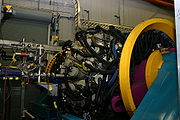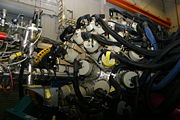
Gammasphere
Encyclopedia


Gamma ray spectrometer
A Gamma-Ray Spectrometer, or , is an instrument for measuring the distribution of the intensity of gamma radiation versus the energy of each photon....
used to study rare and exotic nuclear physics
Nuclear physics
Nuclear physics is the field of physics that studies the building blocks and interactions of atomic nuclei. The most commonly known applications of nuclear physics are nuclear power generation and nuclear weapons technology, but the research has provided application in many fields, including those...
. It consists of 108 Compton-suppressed large volume, high-purity germanium detectors arranged in a spherical shell.
Gammasphere has been used to perform a variety of experiments in nuclear physics. Most experiments involve using heavy ion
Heavy ion
Heavy ion refers to an ionized atom which is usually heavier than helium. Heavy-ion physics is devoted to the study of extremely hot nuclear matter and the collective effects appearing in such systems, differing from particle physics, which studies the interactions between elementary particles...
nuclear fusion
Nuclear fusion
Nuclear fusion is the process by which two or more atomic nuclei join together, or "fuse", to form a single heavier nucleus. This is usually accompanied by the release or absorption of large quantities of energy...
to form a highly excited atomic nucleus
Atomic nucleus
The nucleus is the very dense region consisting of protons and neutrons at the center of an atom. It was discovered in 1911, as a result of Ernest Rutherford's interpretation of the famous 1909 Rutherford experiment performed by Hans Geiger and Ernest Marsden, under the direction of Rutherford. The...
. This nucleus may then emit proton
Proton
The proton is a subatomic particle with the symbol or and a positive electric charge of 1 elementary charge. One or more protons are present in the nucleus of each atom, along with neutrons. The number of protons in each atom is its atomic number....
s, neutron
Neutron
The neutron is a subatomic hadron particle which has the symbol or , no net electric charge and a mass slightly larger than that of a proton. With the exception of hydrogen, nuclei of atoms consist of protons and neutrons, which are therefore collectively referred to as nucleons. The number of...
s, or alpha particle
Alpha particle
Alpha particles consist of two protons and two neutrons bound together into a particle identical to a helium nucleus, which is classically produced in the process of alpha decay, but may be produced also in other ways and given the same name...
s followed by a shower of tens of gamma ray
Gamma ray
Gamma radiation, also known as gamma rays or hyphenated as gamma-rays and denoted as γ, is electromagnetic radiation of high frequency . Gamma rays are usually naturally produced on Earth by decay of high energy states in atomic nuclei...
s. Gammasphere is used to measure properties of these gamma-rays for tens of millions of such gamma ray showers. The resultant data is analyzed to gain a deeper understanding of the properties of nuclei.
Gammasphere was built in the early 1990s and has operated at the 88-inch cyclotron
Cyclotron
In technology, a cyclotron is a type of particle accelerator. In physics, the cyclotron frequency or gyrofrequency is the frequency of a charged particle moving perpendicularly to the direction of a uniform magnetic field, i.e. a magnetic field of constant magnitude and direction...
at Berkeley National Laboratory
Lawrence Berkeley National Laboratory
The Lawrence Berkeley National Laboratory , is a U.S. Department of Energy national laboratory conducting unclassified scientific research. It is located on the grounds of the University of California, Berkeley, in the Berkeley Hills above the central campus...
and at Argonne National Laboratory
Argonne National Laboratory
Argonne National Laboratory is the first science and engineering research national laboratory in the United States, receiving this designation on July 1, 1946. It is the largest national laboratory by size and scope in the Midwest...
.
In the movie Hulk
Hulk (film)
Hulk is a 2003 American superhero film based on the fictional Marvel Comics character of the same name. Ang Lee directed the film, which stars Eric Bana as Dr. Bruce Banner, as well as Jennifer Connelly, Sam Elliott, Josh Lucas, and Nick Nolte...
Bruce Banner is zapped by a machine called Gammasphere. The actual Gammasphere, which detects rather than emits gamma rays, was used as a model for the device shown in the movie.
See also
- Atom Trap at ATLAS
- Canadian Penning Trap Mass SpectrometerCanadian Penning Trap Mass SpectrometerThe Canadian Penning Trap Mass Spectrometer is one of the major pieces of experimental equipment that is installed on the ATLAS superconducting heavy-ion linac facility at the Physics Division of the Argonne National Laboratory...
- Enge Split Pole Spectrograph
- Fragment Mass Analyzer
- Large Scattering Chamber
External links
- LBNL: LBL site.
- ANL site
- Gammasphere Online Booklet Homepage

